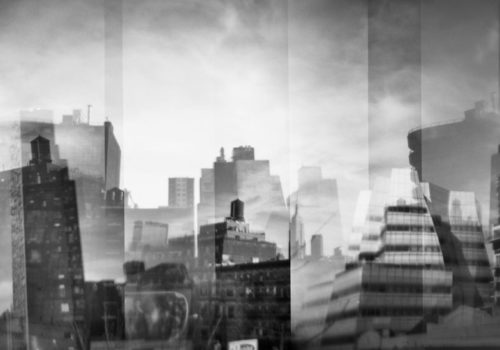The Galerie Duboys knows how to take risks, and it shows in their new exhibition, 3ème tour, musique d’une campagne. The gallery has given five artists carte blanche to express their feelings about this season’s French presidential campaign, which came to a close last Sunday. Two photographers, two visual artists and a street artist come together share their perspectives on current events. The artists worked in secret for weeks on a project unveiled on the opening night of the exhibition. The directors of the gallery called in two outside photographers to produce original work: Stéphanie de Rougé and Frédéric Bourret.
How did you come to participate in this exhibition?
Stéphanie de Rougé: I live in New York, but last January I took a trip to Paris to see some photography friends like Ericka Weidmann, whom I met at the Bourse du Talent in 2009. We caught up over coffee, and I took the opportunity to show her two or three examples of my personal work involving double exposures on medium format negatives. This is something I’ve been working on for a long time but which I’ve been hesitant to share, probably out of fear. She looked at my pictures and seemed to appreciate them, then gave me the best advice I’ve ever received in my life as a photographer: “I think your personal work belongs more to the world of contemporary art than contemporary photography, so that’s whose doors you should be knocking on.” That’s how I came to the Galerie Duboys one freezing January evening.
Frédéric Bourret: It always starts with a meeting… and this meeting happened to be a very good meeting! I came to show my work to Dominique, Nathalie and Thierry, thinking the meeting would last fifteen minutes, we ended talking for three hours. They invited me to participate in 3ème tour and I jumped at the opportunity.
All the work in the exhibition is original. How did approach this project?
SR: The way I always do when I’m given an idea to work from: I take it all in until I can’ take any more, then I grab my camera and go shoot… This time, I immersed myself in political speeches, rallies and newspaper articles of all kinds, then drowned myself in the immaturity, the lies and false promises coming from both sides of the Atlantic (this is also an election year in the US). Little by little I got caught up in the game, then pushed forward blindly to translate this mess into images…
FB: Working on a subject as sensitive as politics, where everyone has their own opinion and defends it body and soul, is an extraordinary adventure. It should convey an unbiased message. An artist’s work, in my opinion, should not be political, otherwise it becomes propaganda and that’s exactly what I try to avoid. The week after that meeting, my head was swimming with possibilities.
Can you tell us a little more about the photographs that you’re presenting here?
SR: These photographs are negative strips that have been exposed multiple times. Whenever I shoot, it’s always the same ritual: I head out with three or four plastic cameras hanging from my neck, all loaded with medium format negatives. I shoot one image, then another, then a third, though not always with the same camera. Then I advance the film at my own rhythm, centimeter by centimeter. Then I start to shoot again. I imagine intertwining lines, shapes fitting together, light and shadows flying by. That’s how I work, in constant dialogue between head and body. I can’t see what I’m doing, of course, but often what I imagine I’m shooting shows up when I develop the film. I hope that everyone will appreciate the result!
FB: I’m presenting a series entitled J + 1, composed of eleven prints, which try to capture the fundamental link between society and the words used in the media. I selected eleven historically significant newspaper headlines, eleven headlines that upset the fragile balance of perception. All these events and facts contribute to the steamroller that is our media. The media and the real world feed off each other, respond to each other, confront each other constantly, giving birth to a new reading of our daily existence.
Stéphanie de Rougé: French photographer (b. 1976) lives and works in New York.
Frédéric Bourret: French photographer (b. 1973), trained in New York, he lives and works in Paris.
3ème tour, musique d’une campagne
Stéphanie de Rougé, Frédéric Bourret (photographers), Raoul Hébréard, Andrey Zouari (French visual artist) and Oakone (street artist)
May 10 – June 23, 2012
Opening: Saturday, May 12, 17h
Galerie Duboys
6 rue des Coutures Saint-Gervais
75003 Paris
Tel: + 33 (0)1 4274 8505
Mail: [email protected]
















